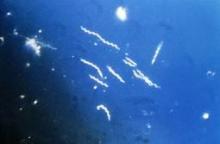Neither children with autism nor unaffected control subjects showed serologic evidence of Lyme disease in a case-control study published May 1 in JAMA.
This finding refutes the idea proposed in 2008 linking Lyme disease with autism spectrum disorders. That theory "has garnered considerable attention," with researchers reporting that some autistic populations showed seropositivity rates of greater than 20% for the tick-borne disease.
The results of this case-control study involving 70 children with autism and 50 unaffected controls should lay that theory to rest. "[Our] study’s sample size was large enough to effectively rule out the suggested high rates of Lyme disease ... among [autistic] children," said Mary Ajamian of the department of medicine, Columbia University, New York, and her associates.
Ms. Ajamian and her colleagues reported their findings in a Research Letter to the Editor. They performed serologic testing for Lyme disease on two populations: 37 children aged 2-18 years who had autism and 27 unaffected siblings, all from the Autism Genetic Resource Exchange (AGRE); and 33 children with autism, 8 unaffected siblings, and 15 unrelated healthy control subjects from the Weill Cornell Autism Research Program (WCARP).
Subjects in the AGRE program resided chiefly in the northeastern and western United States, and their serum samples had been collected during 1999-2001 and stored. The WCARP subjects lived primarily in Connecticut, New Jersey, and New York, and their serum samples had been collected during 2010-2012 and stored.
Two serum samples from patients with culture-confirmed Lyme disease were used as positive controls.
The size of this study population would provide greater than 90% power to detect an association between Lyme disease and autism, based on the assumption that controls would have a prevalence of 1% or less of the infection and that cases would have the suggested prevalence of 20%.
None of the children with autism and none of the unaffected controls showed serologic evidence of Lyme disease by two-tier testing, Ms. Ajamian and her associates said (JAMA 2013;309:1771-3).
On ELISA testing, one child with autism tested positive for anti–Borrelia burgdorferi IgG, and four had borderline positive results for IgM. However, all were found to be negative on confirmatory Western blot testing.
Similarly, four of the control subjects tested positive for anti–B. burgdorferi IgG, one had borderline positive results for IgG, and one was positive for IgM. However, all were found to be negative on confirmatory Western blot testing.
Ms. Ajamian and her colleagues said one possible limitation of the study is the absence of information about the lifestyles of the patients and controls, including the amount of time they spent outdoors. The researchers also pointed out that their analysis did not address the question of whether Lyme disease might cause autism-like behavioral deficits.
This study was supported in part by the Department of Defense and the National Institutes of Health. Ms. Ajamian reported no financial conflicts of interest; her associates reported ties to Immunetics, Bio-Rad, DiaSorin, BioMerieux, Abbott, and Baxter.


